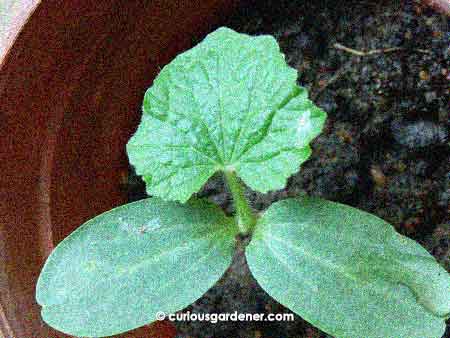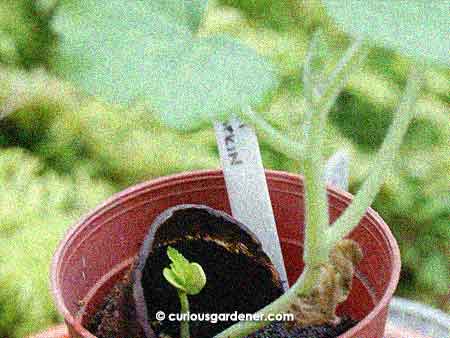This happens to the best and the worst of those of us who grow plants from seeds (and I know who will be nodding vigorously on reading this post).
We gardeners start our seeds in pots or other containers indoors so we can keep an eye on them and give them “safe” conditions to germinate in before we plant them out in the great outdoors …except that there are times when we sow the seeds and nothing happens. We watch and we wait, keeping the soil moist and the pots in bright and warm locations, and after weeks of seeing no activity, we may conclude that the seeds were not viable and decide to use the same pots to start new plants. After all, gardeners like to recycle, right?
Then, when the new plants have started growing – horror of horrors – something germinates next to it and you realize you don’t know what it might be because you’ve replaced the old label with a new one for the new plant.
Sound familiar? ![]()
Well, this has happened to me twice in the last month. I had sown a selection of different seeds in recycled cardboard toilet roll tubes, planning to do another of my easy transplants when they had grown one or two sets of true leaves, only to have several tubes remain barren for almost two months.
Give me some credit – I gave them lots of time to germinate.
Then, when I had my worry about the pumpkin vine needing more siblings to help with pollination, I used two of the “barren” rolls to start new pumpkin plants in. Those germinated within days, and I was satisfied. However, as one of the plants neared transplant stage, a new sprout appeared next to it! With my luck, it was a cucurbitaceae – and you know how all of them have the same kind of leaves…
Surprise, surprise – I can boast here a little, because now that I have some experience under my belt, I could identify the sprout as a bittergourd plant. How did I manage that stroke of genius? Well, there are plants that emit the scent of the fruit they bear when you bruise their leaves, and gently pinching the true leaf of the sprout gave off the unmistakeable smell of bittergourd.
So that was one mystery solved. I transplanted the bittergourd sprout to a recycled cup that had been vacant of plants for some time. I chose it because it was bigger and deeper than any of my other vacant pots at the moment, and it already had soil in it, which made the transplant easy.
Wouldn’t you know it, over a week later, something else started growing in that pot, next to the bittergourd plant, and it didn’t give me any clues as to its true cucurbitceae identity like the helpful bittergourd plant did. It’s not cucumber, snake gourd or bittergourd – I know those three give off their respective distinctive scents – which leaves me to wonder if I’ve finally got a winter melon plant on my hands? I have been going through my stock of seeds rather unsuccessfully over the last few months, and thought that the seeds were not viable any more.

I’m not a fan of unidentified cucurbitaceae sprouts. Their leaves look the same to me! This could be a winter melon, but it could also be a marrow – although I’m fairly certain I didn’t sow any recently. Argh.
This is also one of those times when I’m happy to have my photo library to look through, because I can look for distinctive characteristics of the young plants that I may not have noticed when they were growing earlier. I’d say the possibility that this is a winter melon is quite high, but I’ll know for sure when the fruits appear. If I manage to get the plant that far. Let’s see.
© 2013 curiousgardener.com All rights reserved.

